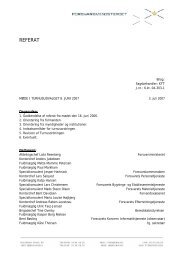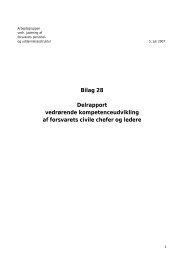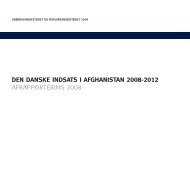Afghanistan Report 2009 - Isaf - Nato
Afghanistan Report 2009 - Isaf - Nato
Afghanistan Report 2009 - Isaf - Nato
You also want an ePaper? Increase the reach of your titles
YUMPU automatically turns print PDFs into web optimized ePapers that Google loves.
<strong>Afghanistan</strong> <strong>Report</strong> <strong>2009</strong><br />
Creation of a Rural<br />
Development School<br />
in Kabul and in Badghis<br />
The Emergency Irrigation<br />
Rehabilitation Project<br />
An irrigation canal<br />
that is being<br />
rehabilitated in<br />
Kabul Province<br />
under a World<br />
Bank-funded<br />
initiative (© World<br />
Bank 2008)<br />
The Emergency Irrigation Rehabilitation Project,<br />
funded by the World Bank, is helping to provide<br />
water to farms with more reliable and equitable<br />
distribution of irrigation water. The rehabilitation<br />
of the national irrigation system in all five river<br />
basins of <strong>Afghanistan</strong> will help increase agricultural<br />
productivity and farm income, improve food security<br />
and livelihoods, and reduce vulnerability to droughts.<br />
To date, 6 regional offices in Kabul, Jalalabad,<br />
Kandahar, Balkh, Kunduz, and Herat have been<br />
established to develop institutional capacity at the<br />
local level. Furthermore, 710 subproject proposals,<br />
costing about 65.9 million USD have been<br />
prepared. Of these, 668 subprojects totalling 56.9<br />
million USD have been approved; contracts for 655<br />
subprojects worth 47.13 million USD are ongoing;<br />
and 570 subprojects worth 33.69 million USD have<br />
been completed. As of January <strong>2009</strong>, the project<br />
has brought over 100,000 hectare of additional<br />
area under irrigation and resulted in substantial<br />
increases in crop yields in the rehabilitated<br />
areas. Additionally, the emergency repair of the<br />
Band-e-Sultan Dam north of Ghazni city, costing<br />
about 500,000 USD, has been completed. The<br />
Feasibility Study of the Lower Kokcha Irrigation and<br />
Hydropower Multipurpose Project on the Kokcha<br />
River in the Amu River Basin is also complete.<br />
Installation of 64 of the 174 hydrology stations in<br />
different parts of the country is complete, while<br />
installation of the remaining stations is ongoing.<br />
(Source: World Bank)<br />
Spain is leading the support to the Afghan<br />
strategy for agriculture. In this strategy,<br />
one of the most interesting proposals is the<br />
creation of a National Rural Development<br />
School in Kabul and a Provincial school in<br />
Badghis, one of the poorest provinces of<br />
<strong>Afghanistan</strong>, to which Madrid has committed<br />
15 million euros.<br />
Furthermore, the Spanish Development Agency<br />
(AECID) works on irrigated land in Badghis,<br />
educating Afghans in modern cultivation<br />
techniques, improving the cattle, as well as<br />
recuperating the plantations of saffron and<br />
pistachio nuts and fighting against rural plagues.<br />
Between 2001 and 2008 the overall contribution<br />
of the Spanish Government to the reconstrucion<br />
and economic and social development of<br />
<strong>Afghanistan</strong> has reached 225 million euros.<br />
According to the Food and Agriculture Organization<br />
(FAO), irrigation systems covering 567,000 hectares<br />
of land, have been rehabilitated since 2004. Through<br />
a variety of programmes, almost 20,000 km of rural access<br />
roads have been constructed or repaired, increasing<br />
access to markets, employment and social services.<br />
More than 500,000 households (36% of villages) have<br />
benefited from small-scale irrigation projects. 27<br />
In 2007, cereal production was 4.6 million tons 28 , more<br />
than twice the 2001 level of 2.0 million tons 29 . The<br />
number of agricultural cooperatives grew from 52 in<br />
2002 to 1,114 in 2007, employing 142,600 people as<br />
opposed to 7,400 in 2002 30 . New and higher quality<br />
varieties of seeds, most of which are produced by a<br />
flourishing private sector, have been introduced on the<br />
Afghan market, contributing to higher yields and ensuring<br />
better tolerance to diseases.<br />
27<br />
ANDS.<br />
28<br />
Cereals represent more than 90% of the overall agricultural<br />
production.<br />
29<br />
FAO.<br />
30<br />
IMF and Afghan Authorties.<br />
37
















